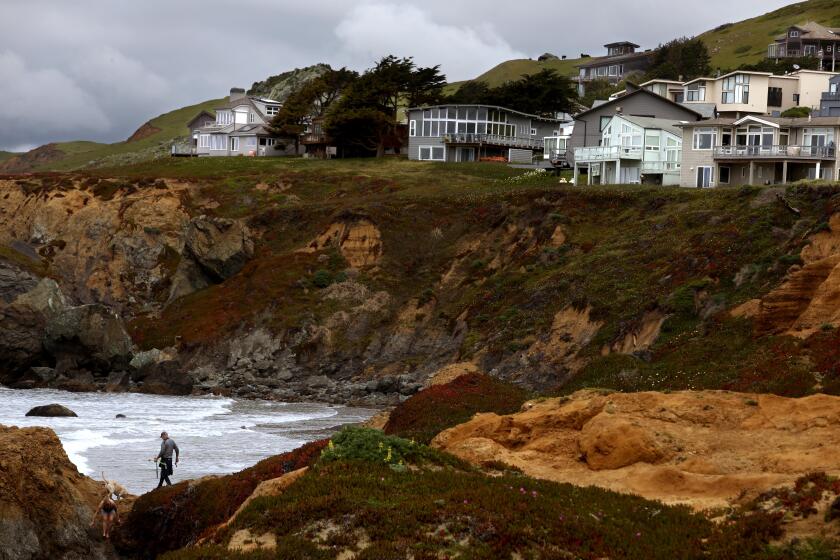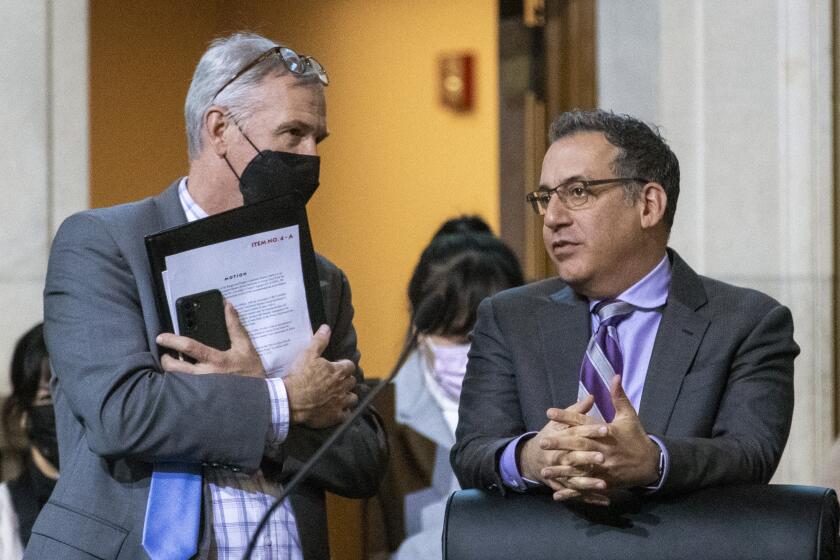Voluntary Limit Proposed by League of Women Voters : Beverly Hills School Board Hopefuls Agree to Spending Cap
In Beverly Hills, where the cost of running a political campaign has escalated dramatically over the last decade, the League of Women Voters is asking candidates to turn back the clock and limit spending.
And six of seven candidates competing in the Nov. 3 Beverly Hills school board election have responded by pledging to limit their campaign expenditures to a maximum of $40,000 each under the terms of an agreement proposed recently by the league. A similar promise is being sought from council candidates in next April’s election.
Gloria Seiff, a league spokeswoman, said that the candidates signed the agreement as part of an effort by the league to encourage school board and City Council candidates to voluntarily put a lid on campaign spending in the affluent community, which has fewer than 20,000 registered voters.
“Campaign costs have escalated too much,” she said. “It came to a head when the cost of running a City Council campaign went over the $100,000 mark (in 1984).”
Community Meeting
The league’s decision to sponsor a campaign finance agreement grew out of a community meeting in July attended by past and present candidates, elected officials, campaign managers and PTA officials.
Seiff said the $40,000 limit was a compromise. “Some people wanted a higher limit, others wanted lower,” she said.
The $40,000 campaign limit, however, is considered high for a Beverly Hills school board election. Board President Betty S. Wilson spent a record $42,824 on her successful 1983 campaign.
“We emphasize that the $40,000 is a maximum,” Seiff said, “but we would certainly welcome a lesser amount.” The six candidates who signed the agreement last week all said they plan to spend considerably less than the limit.
As part of the agreement the school board candidates promised to submit financial forms to a special review committee and to sign a pledge to campaign fairly. The candidates also agreed to attend a league-sponsored campaign kickoff from 2 to 4 p.m. on Sept. 27 at Beverly Hills High School.
Questions already have been raised about the fairness of asking challengers seeking name recognition in the community to limit spending, particularly when they are competing against well-known incumbents. The league contends that by lowering the cost of campaigning, more candidates will be encouraged to run.
Ten years ago, the cost of running a campaign in Beverly Hills ranged between $10,000 and $30,000. And the candidates ran their campaigns very much like they do today, except that more volunteers were used to do such work as handing out leaflets, putting up lawn signs, telephoning and meeting with registered voters.
Cost Has Doubled
Today, however, the cost of campaigning has more than doubled, in part due to inflation and the use of pollsters and professional coordinators with paid staffs and of computerized mailings targeted to specific audiences. Some candidates have increased their expenses by throwing lavish campaign kickoff and Election Night parties where free food and drinks are served.
“And you would see the same people making the rounds to all the kickoffs to sample the food,” said a former candidate.
More than 600 guests attended Maxwell H. Salter’s council campaign kickoff in 1986 including Los Angeles Mayor Tom Bradley and Secretary of State March Fong Eu.
Salter, who spent $97,000 on his successful campaign, said that the biggest expenses were advertisements and citywide mailings.
“I’m in an advantaged position, because I have a few more bucks than the next guy,” said Salter, who owns Beano’s, a chain of family fashion stores. “I tried to set some limitations . . . but the whole idea of American politics is as crazy as a $3-bill.
“If you compare the amount of money spent with the number of votes cast, I would have been better off handing out $3-bills with yellow (tags) that read ‘Vote for Max,’ ” he said.
More than $225,000 was spent by the six candidates in the April, 1986, race for two council seats. Salter and Robert K. Tanenbaum, who spent $55,285, won election. Former Mayor Annabelle Heiferman spent $81,000 and lost.
Two years earlier, eight candidates spent $380,000, more than in any other council election in the city’s history. The big spenders in that race all won.
Record Spending
Councilman Benjamin Stansbury spent $66,000 and Councilwoman Donna Ellman spent $75,000. Councilwoman Charlotte Spadaro captured the individual record by spending $108,693 on her successful campaign, which more than doubled the previous record of about $48,000 set in 1982 by Heiferman. Three candidates in that race spent more than $40,000 apiece and lost. Only 6,000 voters or roughly a third of the city’s registered voters cast ballots.
Ten years ago, the campaign financing picture was different.
In 1976, Joseph N. Tilem ran for City Council and won with a budget of less than $15,000. “I did a lot of walking and talking to people,” he recalled. “I spoke with neighbors and friends at coffee hours, I took out ads in local newspapers and I sent two mailings in the city. But then postage was cheaper, printing was cheaper and advertising was cheaper. I had a lot of volunteers and I used bumper stickers.
“I remember someone telling me that he saw my bumper as far away as Malibu.”
Tilem said he had a kickoff party in his home and friend brought food to serve to guests. “Now kickoff parties are major social banquets worthy of a fund-raiser,” he said. “It used to be said that money won’t buy election in Beverly Hills. You had to be involved in the community for a long time to run. But now people are using a lot of money to hire professionals and it offends some people. It should not be a matter of how rich you are.”
Opposing Incumbents
Former Councilman Charles Aronberg spent close to $30,000 when he first ran for the council in 1972. “That was quite high for the time, but I was running against three incumbents,” he said.
He described the campaign limit as an excellent method to get candidates to “focus away from money and on the issues and ideas that are important in any race.”
Reaction to the limitation agreement has been mixed.
“There is an unfair aspect to it,” Tanenbaum said. “A limitation prevents an unknown person from (spending the money on campaign advertising) to become known. In that way an incumbent has an advantage over a non-incumbent. I don’t think a ceiling is the way to do it, but we have to find some way of encouraging more people to run for office.”
Rudy Cole, who has managed several campaigns in the city, supports the limit. He said that incumbents may have an advantage under a limit, but they also have an advantage in raising money over non-incumbents.
‘Obscene’ Spending
“I think it is about time there was a limit on spending,” he said. “The amount of money we have been spending on campaigns is obscene.”
Of the seven candidates in the school board election, only John R. Hineline refused to sign agreement.
“I feel that the limit that was set up was not a limit, but might be misconstrued as a goal to some people,” he said. “It is not the position of the league to set up guidelines on spending for candidates especially when the amount is extremely excessive.”
Other board candidates supported the cap on spending even though they all said it was set too high.
“I think it is a wonderful idea,” school board President Wilson said. “In my last campaign I personally put up two-thirds of the money I spent ($42,000) and this time I hope to keep it as low as I can and still get my message across.”
Candidate Sheffy Eloul, a social worker, said she would like everyone to spend $5,000 and donate the rest of the money to the Beverly Hills Education Fund.
Teacher’s Salary
“When I heard they were going to make the limit $40,000, I said to myself, ‘My God, that is one year’s salary for a teacher.’ ”
Candidate Phillip J. Scheid said, “Money can affect the outcome of an election. I think that a limit is the only way to give a chance to people who may not have the financial clout that others do.”
School board member Frank Fenton, also a candidate, said the limit will “send a message to the community to get back to basic, grass-roots campaigning and stop spending ridiculous amounts of money.”
Candidate Sharon Flaum said she opposed the agreement at first, because she felt that $40,000 was too high. However, she said she signed because “I recognize that it is just a first step.”
Candidate Peggy Elliott Goldwyn said Beverly Hills needs to realize that it is a small community. “What is needed is to talk to people and listen to their concerns,” and that does not take a lot of money, she said.
More to Read
Start your day right
Sign up for Essential California for news, features and recommendations from the L.A. Times and beyond in your inbox six days a week.
You may occasionally receive promotional content from the Los Angeles Times.






